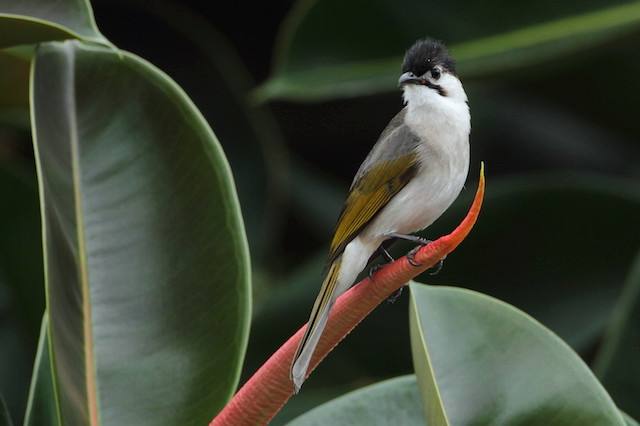Pycnonotus taivanus
IUCN
LCBasic Information
Scientific classification
- name:Pycnonotus taivanus
- Scientific Name:Pycnonotus taivanus,Styan's Bulbul,Aconitum
- Outline:Songbird
- Family:Passeriformes Bulbulidae Bulbul
Vital signs
- length:About 18 cm
- Weight:20-35g
- lifetime:5-15years
Feature
It is the county bird of Taitung County, Taiwan Province, China.
Distribution and Habitat
The Taiwan Bulbul is a species endemic to Taiwan Island, China. It is mainly distributed in the eastern half of Taiwan and the area south of Pingtung. It is occasionally seen in the lowlands (Huangdong) and Hengchun Peninsula in southeastern Taiwan. It is found in lowland ecological environments where there are no white-headed bulbuls. There is a slight overlap in the distribution of the two near Fangliao.
It is mainly distributed in plains to medium altitude areas, up to 600 meters above sea level. It inhabits shrubs, secondary woodlands, hilly land, farmland, forest gardens and orchards, and sometimes in small shrubs or trees. Woods, orchards, and parks are all places where they move around, and they often appear near human houses.
Appearance
The body length of the Taiwan Bulbul is about 18 cm, the peak of the bill is 16.5-18 mm, the wings are 77-88 mm, and the tail is 74-81.5 mm. The entire head, including the forehead, top of the head, nape, and nape, is black, the cheeks and ear feathers are white, there is a small orange-red spot on each side and the base of the lower beak, the eyes are decorated with white, and the zygomatic stripes are black. The upper back is light earthy brown, the small coverts on the back, shoulders, waist, and wings are gray-brown and decorated with olive green, the large coverts, flight feathers and tail feathers are dark brown, the outer vanes are decorated with olive yellow, the chin and throat are white, and the rest of the lower body skin is yellow-white with gray-brown on the chest and flanks, and the lower tail coverts are brown-white with olive feather edges.
The iris is brown, the bill is black, and the feet are dark brown.
The appearance and feather color of the Taiwan Bulbul are
Details
Taiwan Bulbul [bēi] is a medium-sized bulbul with no subspecies

Taiwan Bulbul is a resident bird. It is a typical forest-dwelling bulbul and belongs to the low-to-medium altitude bird. They usually move in small groups of 3-5 or more than 10, and in winter they also move in large groups of 20 to 30. They like to live in shrubs or fruit forests, on the tops of low trees or on sugarcane and reed spikes. They are lively and often play with each other in the forest, chasing and singing, which is quite noisy. Generally, they fly to a branch together, and then fly to another branch together.
Taiwan Bulbul is an omnivorous bird. It mainly feeds on insects and their larvae, fruits, berries or seeds, and some also feed on leeches. They will catch insects in flight, and also climb along tree trunks or branches like the leeches to find prey hidden in the cracks of the bark.
The breeding season of Taiwan Bulbul is from April to August every year, and it is a monogamous bird. During the breeding period, the bird is very active, often standing on the treetops and singing loudly, or the male and female birds chase each other, fly and play between the tree crowns and flowers. Usually nests are built on low trees such as shrubs, bamboo clumps and fruit trees. The nests are mostly placed between the branches of shrubs or bamboo clumps. They are also found in banana forests and on the petioles of banana leaves. The nest is bowl-shaped, with a rough and loose outer layer, mainly composed of dead grass stems, dead grass leaves and grass roots, and a tight inner layer, mainly woven from bark fibers, hemp, fine grass roots, etc. The nest is padded with soft materials such as animal hair, down feathers, and hemp. It is 0.2-2.1 meters from the ground. The nest is built by both male and female parents. After the nest is built, they start laying eggs. Each nest usually lays 3-4 eggs. The eggs are nearly light purple with brown-red spots, and some are grayish white with orange-red and purple-brown spots. The average size of the eggs is 21 mm × 16 mm. The male and female parents take turns to incubate the eggs, but the female is the main one. The incubation period is 12 days. The chicks are late-maturing. After hatching, the male and female parents raise them together. Generally, the chicks can leave the nest in about 14 days.
The Taiwan Bulbul was discovered by F. Styan, a British expatriate living in Shanghai, by chance. Although it is quite common in some areas, its distribution range is limited and the total amount is not large. Due to the destruction of habitats and hybridization with the same genus white-headed bulbul, the number of these two bird species has overlapped in some areas, and some white-headed bulbuls have been released into the Taiwan Bulbul habitat for religious reasons.
Listed in the "Red List of Endangered Species of the World Conservation Union" (IUCN) 2016 ver 3.1-Vulnerable (VU).
Listed in the "National List of Terrestrial Wildlife with Important Economic and Scientific Research Value" (Item 365) issued by the State Forestry Administration of China on August 1, 2000.
Listed in the second level of China's "National Key Protected Wildlife List" (February 5, 2021).
Protect wildlife and eliminate game.
Maintaining ecological balance is everyone's responsibility!








